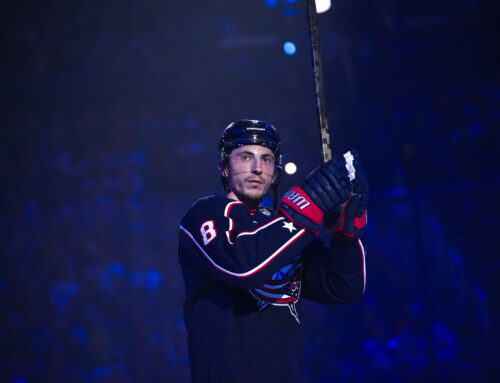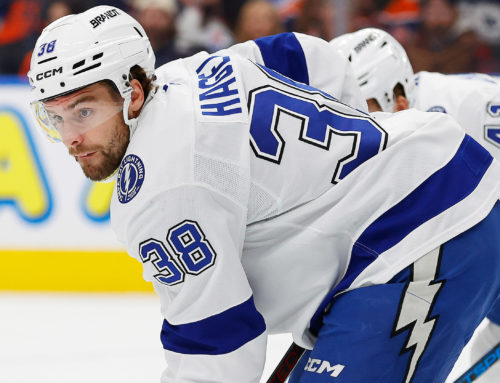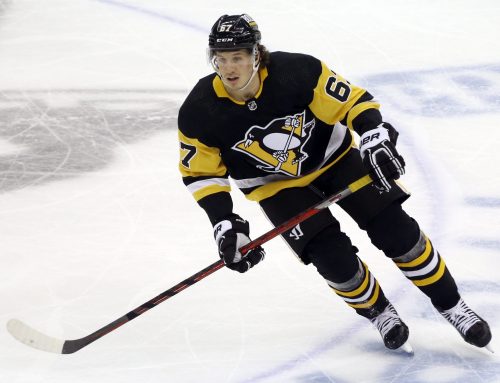We are back with Week 2 of our dive into advanced stats and how they are related to projections. Make sure you pick up the Dobber Fantasy Guide for the most up-to-date info out there, but this series should help in understanding why some projections look the way they do and in developing your own. In week one we aligned even-strength IPP and who it might mean is in line for regression. Since we can't ever really take one of these stats in isolation, they don't alone paint a full picture, this week we are going to move on to five-on-five shooting percentage.
First up, definitions. Five-on-five shooting percentage, or 5-on-5 S% as it is listed in the reports, is another even-strength stat. Again, like with last week, even-strength numbers are an important baseline as they show the largest sample size, and are therefore likely to be the most accurate and consistent numbers. This does not mean that other play times, particularly power-play, are unhelpful – they most certainly are important, but it does mean they are often much more subject to variation.
Five-on-five shooting percentage measures the team's shooting percentage while a given player is on the ice at five-on-five. It is different than personal shooting percentage as it measures the number of goals from everyone on the ice from all of the shots taken while a player is on the ice, not just their own. Like with personal shooting percentage though, and IPP there are certain expectations we have of this number so we can use it to tell us a bit about what is happening around a current player which gives us important context to their current point production. In the case of five-on-five shooting percentage, we expect to see a number around eight percent, maybe between eight and nine. Among players who played at least 30 games, and scored at least 30 points in 2019-20 the average five-on-five shooting percentage was 8.01%. There are some player effects here too, but much less pronounced than in IPP. For example, over the last five years, Connor McDavid's five-on-five shooting percentage is 10.5 percent, Nikita Kucherov is at 10.02 and Patrick Kane has been at 9.74, but even Sidney Crosby has averaged right on target at 8.5 percent. The moral of the story here is that while we do have some baseline numbers here it is always a good idea to look at a player's personal history to see how the data compares.
So how do we compare this data? If we see a player's season (or season-to-date performance) and see a number that is a big deviation from the league average or personal history then we have an inkling that something is up. Like with IPP when we see a change we need to figure out if something on the ice has happened that makes that change seem reasonable, and if not, it may mean that player is due for some regression.
For example, Mika Zibanejad put up a five-on-five shooting percentage of 10.7% in 2019-20. That number is Connor McDavid levels and is significantly higher than the league average, higher than his five-year average (8.9%), and leaps and bounds higher than the 2018-19 number of 6.17%. I would hypothesize that the 6.17% was a bit low for him given his average and that we should have seen a bit of a rebound in 19-20, though would not have expected a rise to 10.7%. So essentially that begs the question, did Zibanejad (or something in his context) morph into another McDavid, or was his percentage unsustainably high? We know some things changed through the season, he played more per night (over 20 minutes a night – though that wouldn't impact his percentage numbers), and formed some nice chemistry with Pavel Buchnevich and Chris Kreider. Neither of those things really seem to justify McDavid level percentages. Add to that a higher-than-average IPP, and a personal shooting percentage well above his average that 108-point pace is looking a bit too high.
And now on to some data. The first table shows us the players with the largest negative differences between their three-year average and their 2019-20 season. These are the players whose five-on-five shooting percentage were higher than average and are therefore at the most risk for regression to hurt their 2020 pace.
| Name | Pos | Age | Team | GP | 5on5 S% | 3 YR Average | Δ |
| ANDREW MANGIAPANE | L | 24 | CGY | 68 | 9.7 | 6.40 | -3.30 |
| BRYAN RUST | R | 28 | PIT | 55 | 12.2 | 9.13 | -3.07 |
| RYAN STROME | C | 27 | NYR | 70 | 10.5 | 7.87 | -2.63 |
| NAZEM KADRI | C | 30 | COL | 51 | 11.5 | 8.87 | -2.63 |
| J.T. COMPHER | L | 25 | COL | 67 | 9.6 | 7.03 | -2.57 |
| JAKOB SILFVERBERG | R | 30 | ANA | 66 | 10 | 7.87 | -2.13 |
| RASMUS RISTOLAINEN | D | 26 | BUF | 69 | 9.5 | 7.37 | -2.13 |
| MIKA ZIBANEJAD | C | 27 | NYR | 57 | 10.7 | 8.57 | -2.13 |
| ARTEMI PANARIN | C | 29 | NYR | 69 | 12.2 | 10.07 | -2.13 |
| MARTIN NECAS | C | 21 | CAR | 64 | 7.3 | 5.20 | -2.10 |
A number of these players found themselves in new positions – Andrew Mangiapane, Bryan Rust, Ryan Strome, and even to some extent Mika Zibanejad. Given that, we might have some reason to believe that changes in their five-on-five shooting percentage could be sustainable, but unfortunately in most cases the change might just be a bit too large.
Bryan Rust was bouncing around between 8.5% and 6.5% until 2019-20 when he was promoted to play with Crosby and he then shot up to 12.2%. We might be able to believe that number if his new linemates were both up above 12% consistently, but they are not. Both Crosby and Jake Guentzel have been averaging around 8.5% over the last three seasons. That definitely implies that the 60 even-strength point pace that Rust was on is not going to be sustainable in 2020.
Ryan Strome is another interesting example. He spent the prior two seasons below seven percent before shooting up to 10.5% in 2019-20. That number is looking a bit high, but part of what changed for him was moving up to play with Artemi Panarin (who also makes this list). Panarin is a much more effective player than Strome's previous linemates and has consistently had a five-on-five shooting percentage of over nine percent. There is a chance here that Panarin is that much more effective at scoring or setting up plays than Strome's previous linemates that we might expect some of this boost to remain in 2019-20. Given Strome's personal history, likely not all of it, but if he can stay with Panarin he does have a chance.
Our next list shows the opposite of the first – players whose three-year average is higher than their 2019-20 data, so implying they could be in for a bounce-back at five-on-five.
| Name | Pos | Age | Team | GP | 5on5 S% | 3 YR Average | Δ |
| WARREN FOEGELE | L | 24 | CAR | 68 | 8.1 | 11.67 | 3.57 |
| ADRIAN KEMPE | L | 24 | L.A | 69 | 4.2 | 6.60 | 2.40 |
| YANNI GOURDE | C | 28 | T.B | 70 | 7.1 | 9.47 | 2.37 |
| TYLER SEGUIN | C | 28 | DAL | 69 | 5.7 | 7.80 | 2.10 |
| SEAN MONAHAN | C | 26 | CGY | 70 | 7.1 | 9.13 | 2.03 |
| PHIL KESSEL | C | 33 | ARI | 70 | 5.7 | 7.57 | 1.87 |
| JAMIE BENN | L | 31 | DAL | 69 | 6.7 | 8.50 | 1.80 |
| JONATHAN MARCHESSAULT | C | 29 | VGK | 66 | 7.1 | 8.87 | 1.77 |
| JOHNNY GAUDREAU | L | 27 | CGY | 70 | 7.5 | 9.23 | 1.73 |
| ALEXANDER RADULOV | R | 34 | DAL | 60 | 6.5 | 8.23 | 1.73 |
One observation right off the bat is that we have two Calgary top-liners and several Dallas players on this list. Anyone who owned these guys in 2019-20 can attest that their performances were definitely lack-luster. Age could be a factor for guys like Jamie Benn and Alex Radulov, and we could be seeing a bit of a decline that they don't fully bounce back from, but for Tyler Seguin, Sean Monahan, and Johnny Gaudreau, their inclusion on this list is a sign that 2019-20 might have been an anomaly.
Phil Kessel is a bit of a concern though. While his drop to 5.7% is significant and seems like it wouldn't be sustainable we do have to remember that he moved from his most common linemate being Evgeni Malkin to Derek Stepan. Five-on-five shooting percentage looks at all of the goals scored while you are on the ice, so the quality of your linemates matters. Malkin has been roughly between 8.5% and 10.5% over the last four seasons, while Stepan has failed to break seven percent in two consecutive seasons (and has been struggling largely since coming to Arizona). Kessel's 45-point pace might be a bit low overall, his personal and five-on-five shooting percentages will likely rebound a bit, but with his new teammates and Arizona's playing style, it seems unlikely he returns to his previous numbers.
That is all for this week. Thanks for reading.
Stay safe out there.
Want more tool talk? Check out these recent Frozen Tool Forensics Posts.





 FLA
FLA CAR
CAR MIN
MIN BUF
BUF EDM
EDM DET
DET TOR
TOR ANA
ANA
